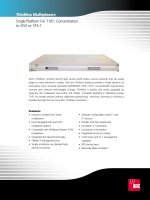Tài liệu Working sheet for tax credit relief for Gift Aid donations, pension contributions and trading losses pptx
Bạn đang xem bản rút gọn của tài liệu. Xem và tải ngay bản đầy đủ của tài liệu tại đây (1.38 MB, 4 trang )
Tax Credits
Working sheet for tax credit relief
for Gift Aid donations, pension
contributions and trading losses
Use this working sheet to help you work out your income for tax credits purposes.
Please make sure that you keep the working sheet or a record of your calculations, in
case we have any questions.
Who should fill this in?
The person who has made the Gift Aid donations, pension contributions or trading
loss. If you are part of a joint claim and either of you made any of these payments or
a trading loss, then the first named person on your tax credits claim should fill in this
working sheet.
If you used the ‘Earnings as an employee’ working sheet in the Notes sent with your
tax credits claim form or Renewals Pack, you may already have deducted any
personal pension contributions you paid direct (for example, Free-Standing
Additional Voluntary Contributions or payments to Stakeholder pensions) from your
employment earnings. If you have, do not use this working sheet unless you (or in a
joint claim, your partner) have made other personal pension contributions, Gift Aid
donations or a trading loss.
‘Your partner’ on this working sheet refers to the person you have claimed tax credits
with, and does not refer to your business partner.
If you have made a joint claim, please remember:
• to enter your partner’s name on the working sheet
• that your total income includes both your and your partner’s income.
Step 1
Work out your income using the working sheets included in the Notes sent with your
tax credits claim form or Renewal Pack.
Note 1 – benefits from your employer
For information on what to include please go to:
• Part 5.4 of the notes sent with your tax credits claim form, or
• Page 8 of the notes sent with your tax credits Renewal Pack.
Your employer usually tells you the taxable values on a form P9D or P11D and, for
tax credits purposes, the benefit may include:
• any goods or assets that you could sell for cash
• any personal liabilities (for example, your gas or electricity bill) which were paid
by your employer
• vouchers and credit tokens, except those used to pay for registered childcare
• car mileage allowances or payments towards the running costs of your car
• company cars and car fuel
• taxable expenses payments.
Where benefits in kind have been payrolled by your employer and included in your
P60 or P45, you will need to deduct the cash equivalent/taxable amount of all
benefits in kind from the total in the P60 or P45. Then add back in at box 5.4 on the
claim form the cash equivalent/taxable amount of any relevant benefits in kind listed
on Page 14 of the Notes, using P11D or P9D provided by your employer.
Help
If you would like more help:
• go to www.hmrc.gov.uk/taxcredits
• phone our helpline on
0345 300 3900
• textphone our helpline (for people
with hearing or speech difficulties) on
0345 300 3909
• write to us at:
Tax Credit Office
PRESTON
PR1 4AT
For our opening hours go to
www.hmrc.gov.uk/contactus
Customers with particular
needs
We offer a range of facilities for
customers with particular needs,
including:
• wheelchair access to nearly all
Enquiry Centres
• help with filling in forms
• for people with hearing difficulties
— Text Relay
— induction loops.
We can also arrange additional support
such as:
• home visits, if you have limited
mobility or caring responsibilities
and cannot get to one of our
Enquiry Centres
• the services of an interpreter
• sign language interpretation
• leaflets in large print, Braille and audio.
For complete details please:
• go to
www.hmrc.gov.uk/enq/index.htm
• phone the helpline on
0345 300 3900
• textphone the helpline (for people
with hearing or speech difficulties) on
0345 300 3909.
Your rights and obligations
Your Charter explains what you can
expect from us and what we expect
from you. For more information go to
www.hmrc.gov.uk/charter
continued >>>
TC825 Page 1 HMRC 01/12
Note 2 – other income
Other income includes:
• income from savings and investments
• State Pensions and other UK pensions
• property income
• trust income
• foreign income
• notional income.
Enter the total amount of your other income that exceeds £300 (if you are claiming
as a couple the £300 limit applies to your joint other income) plus for students, any
Adult Dependant’s Grant, or miscellaneous income received.
Note 3 – property income
Letting property does not constitute a trade, so should not be included in any
income from self-employment.
Rental property
If you have a rental property that made a loss, relief for tax credit purposes is
generally given in the same way as for Income Tax. If you made a loss, include ‘0’ in
respect of this income in your calculation of ‘other income’ for the year.
Losses on property income
Normally, the loss should be carried forward and set off against profits from the
same source in the following tax year. From 6 April 2011, the same rule applies to
furnished holiday lettings, including losses unrelieved at 5 April 2011. If, however,
part of the loss arises from capital allowances or from agricultural land, that part of
the loss may be set against other income which you (but not your spouse or partner)
may have, either in the tax year in which the loss was made or in the following tax
year.
In such cases, the amount of loss relief available for tax credit purposes is based on
your tax calculations. Please see Example 1 opposite.
Step 2
Deduct the gross amount of any:
• qualifying Gift Aid donations
• personal pension or retirement annuity contributions.
For example, if you made a Gift Aid donation in 2011–12 of £100, your gross
donation will be £125 (£100 multiplied by 100, then divided by 80). Enter the total
amount on the working sheet.
Step 3
Deduct the trading loss (of the year forming the basis of the claim) from the ‘Total
income’. A trading loss only arises where a trade is carried out on a commercial basis,
with a view to making a profit.
The tax credits rules on trading losses operate separately from those for Income Tax.
This means that for tax credit purposes you deduct the trading loss from:
• any other income you may have for that year
• in a joint claim, any other income which you and your partner have for that year.
Example 1
James and Sarah are married. Sarah
stays at home to look after the children.
James has income in 2011–12 from
self-employment of £25,000. He also
lets several properties. The income and
expenses of all the lettings are included
in a single rental business.
During 2011–12, James incurred
allowable expenditure on his lettings
business which resulted in a loss of
£15,000. This loss would usually be
carried forward and set against
subsequent profits of the lettings
business. However, James has some
net capital allowances due on his
rental business, so part of the loss may
be set against his general income for
that tax year.
For Income Tax purposes, the following
items were included in arriving at
the loss:
• capital allowances of £10,000
• balancing charge adjustment
of £8,000
leaving net capital allowances of £2,000.
For tax credits purposes, James can
claim tax credits loss relief for 2011–12
of £2,000.
When completing his form TC603D
Annual Declaration, giving his income
for the tax year 2011–12, James may
set £2,000 of his rental property loss
against his self-employed income of
£25,000. The balance of the loss
(£13,000) is to be carried forward and
set against his future profits from his
lettings business (but not against his
future general income).
Page 2
Put simply, calculate the total of your reliefs and losses.
Add your gross Gift Aid donations
£
A
Plus gross personal pension or retirement
annuity contributions
£
B
Plus your trading loss
£
C
Equals
Total loss and relief
£
D
If D is less than your total income, deduct this amount from the boxes in the order in which they appear
on your tax credits claim form or Declaration form, whichever applies. Please see the example at the
bottom of this page.
If D is equal to or more than your total income, enter ‘0’ in every box in:
• Part 5 of your tax credits claim form
• Part 2 of your form TC603D Annual Declaration, or
• Part 1 and/or Part 2 of your form TC603D2 Tax Credits Declaration.
Losses brought forward
If this does not use up the entire loss, the balance (that is, the unused part of the loss after deducting the
amounts set against other income in the year the loss arises) may be carried forward to be set against the
profits of the same business in a future tax year.
For example, if you had a loss in 2010–11 (the ‘previous year’ for the purposes of tax credits claims in
2011–12) and there is some loss remaining after the deduction from other income from 2010–11, the
unused part of the 2010–11 loss may be brought forward and deducted from the profits of the same
business in the tax year 2011–12.
Example 2
Helen is employed by ABC Holding. Her P60 shows that she earned £18,870 (before tax and other
deductions) in 2011-12. She handles all the paperwork at home, so when she filled in the tax credits claim form
she gave her details for ‘You’ and her husband Derek’s details for ‘Your Partner’.
Derek is self-employed and made a loss af £10,500 in 2011-12.
They have no other
reliefs to claim. Their
£
0
A
total joint income is
£
0
B
£18,870.
£
10 500
C
Box D is less than their
£
10 500
D
total income.
Helen needs to deduct £10,500 from the
amount that should go in the box(es) on
her Annual Declaration.
She enters £8,370 in box 2.2 for ‘You’
(£18,870 - £10,500 = £8,370) and ‘0’ in box
2.4 for ‘Your partner’.
Page 3
to
6 / April / 20 5 / April / 20
Working sheet to calculate relief and losses
Your income for the tax year
Your details (see ‘Who should fill this in?’ on page 1)
Name National Insurance number
Your partner’s details (for joint claims only)
Name National Insurance number
Gift Aid, personal pension or retirement annuity contributions and trading losses
Step 1 - total your income
Taxable social security benefits
You Your partner Total
Earnings as an employee
Benefits from your employer
(see Note 1 on page 1)
Income from self-employment
where there is a loss for that
person, enter ‘0’ in their box
Total other income combined (see Notes 2 and 3 on page 2)
Total income
Step 2 - deduct the following
£ £ £
£ £ £
£ £ £
£ £ £
£
£
£
A
£
B
£ £
Gross Gift Aid donations
Gross personal pension or
£ £
retirement annuity contributions
Balance of income
Step 3
£
Deduct your trading loss
£
this is the loss that arose in the year
forming the basis of your tax credits claim
Balance of income
if minus, balance of trading loss to be carried
forward against future profits of the same trade
£
C
£
£
Page 4









